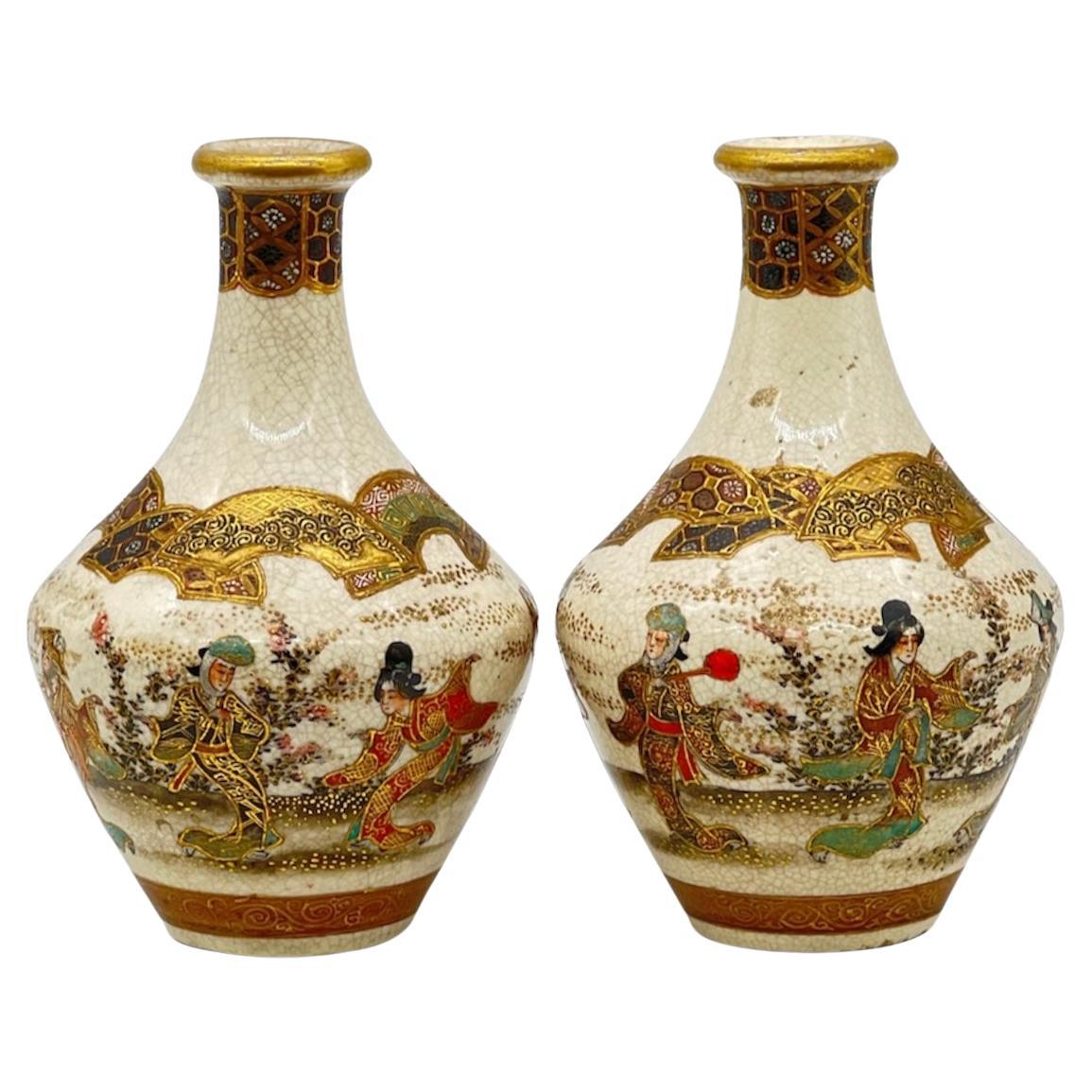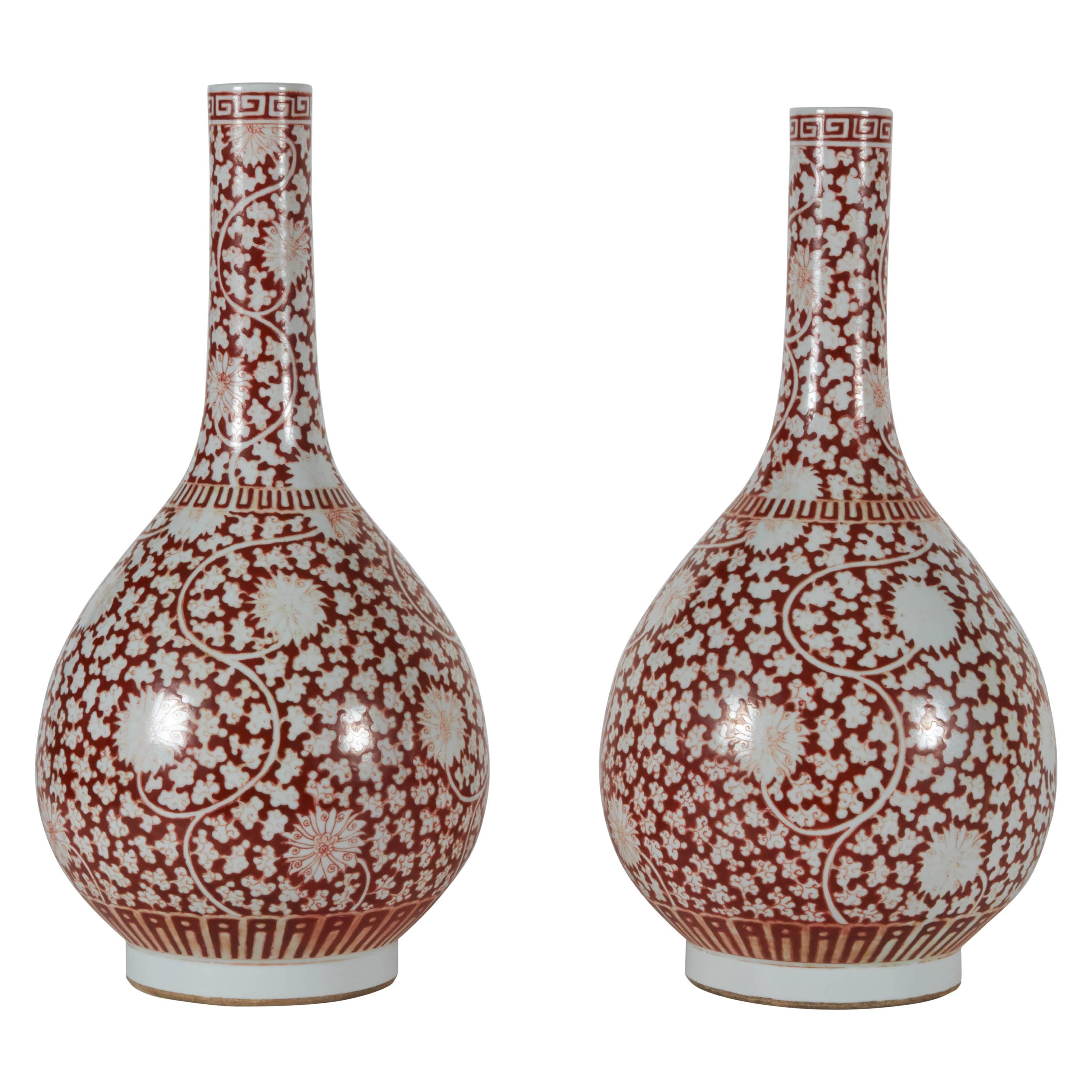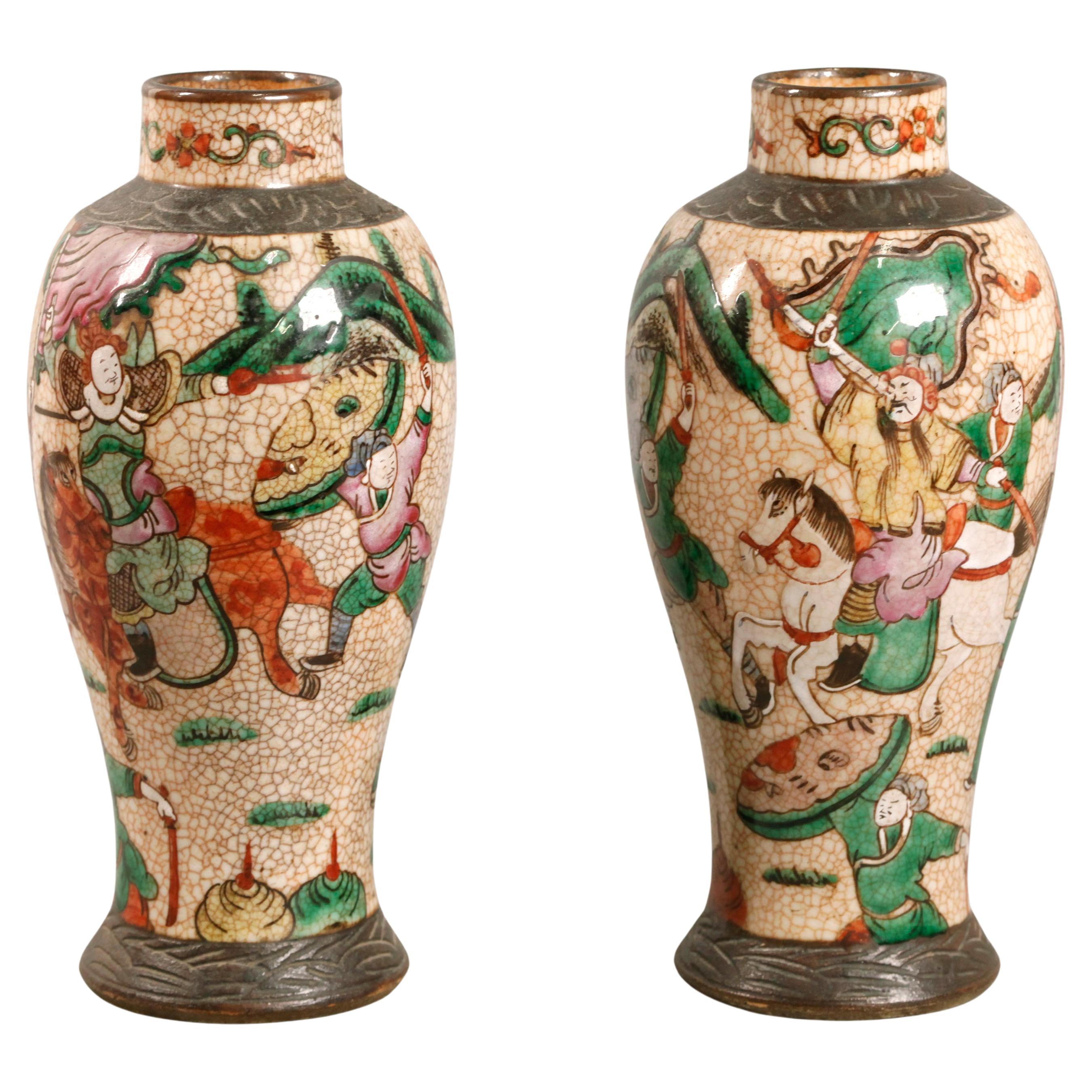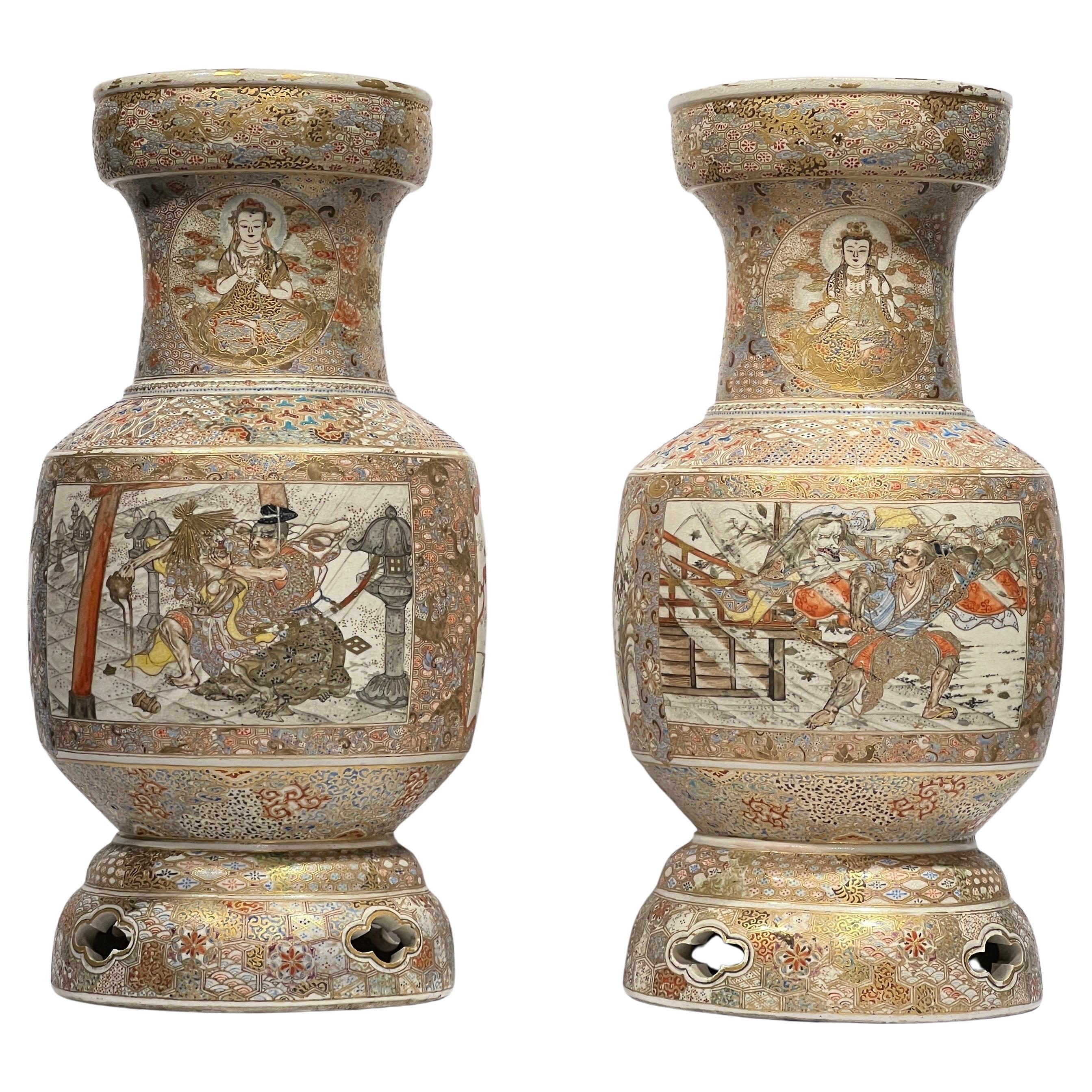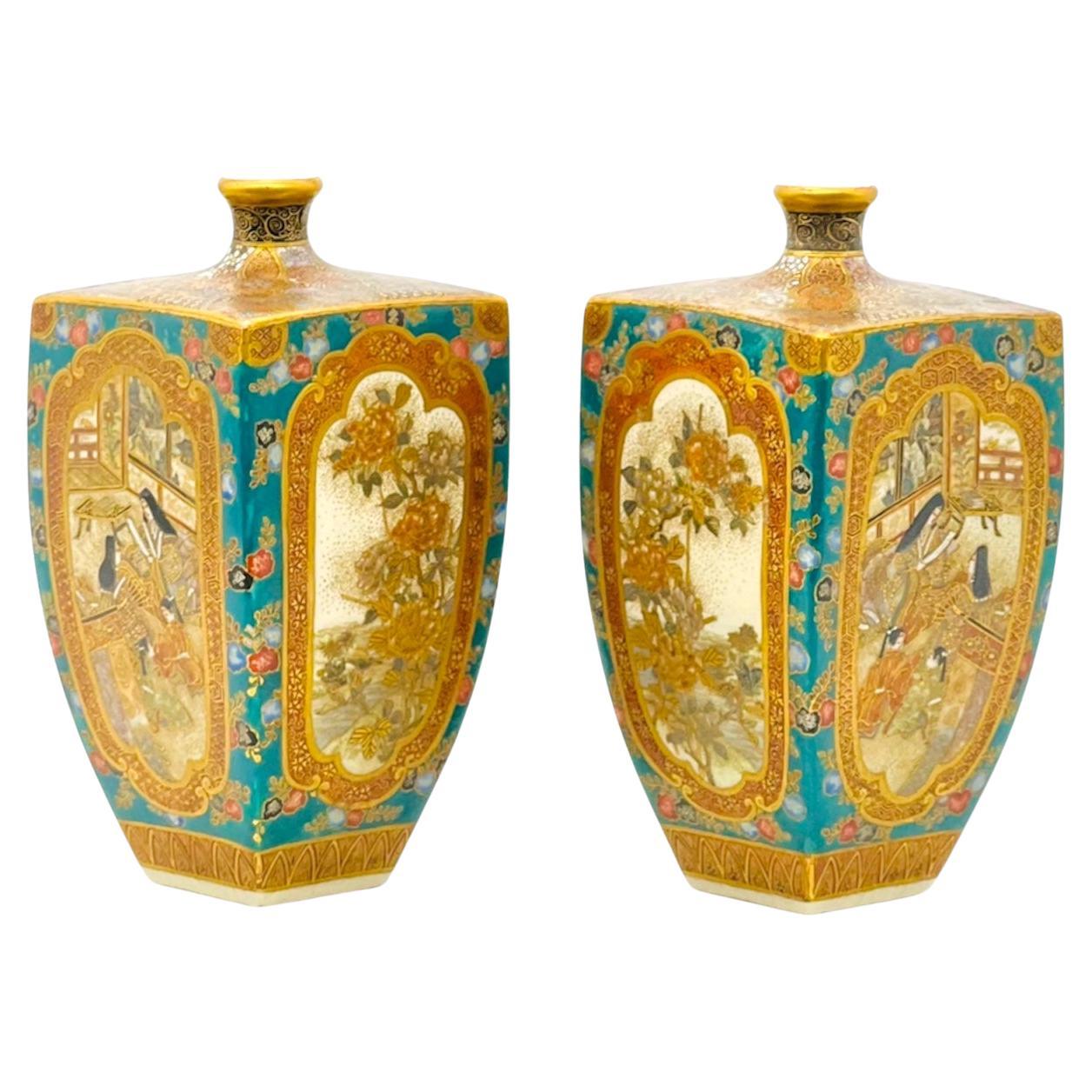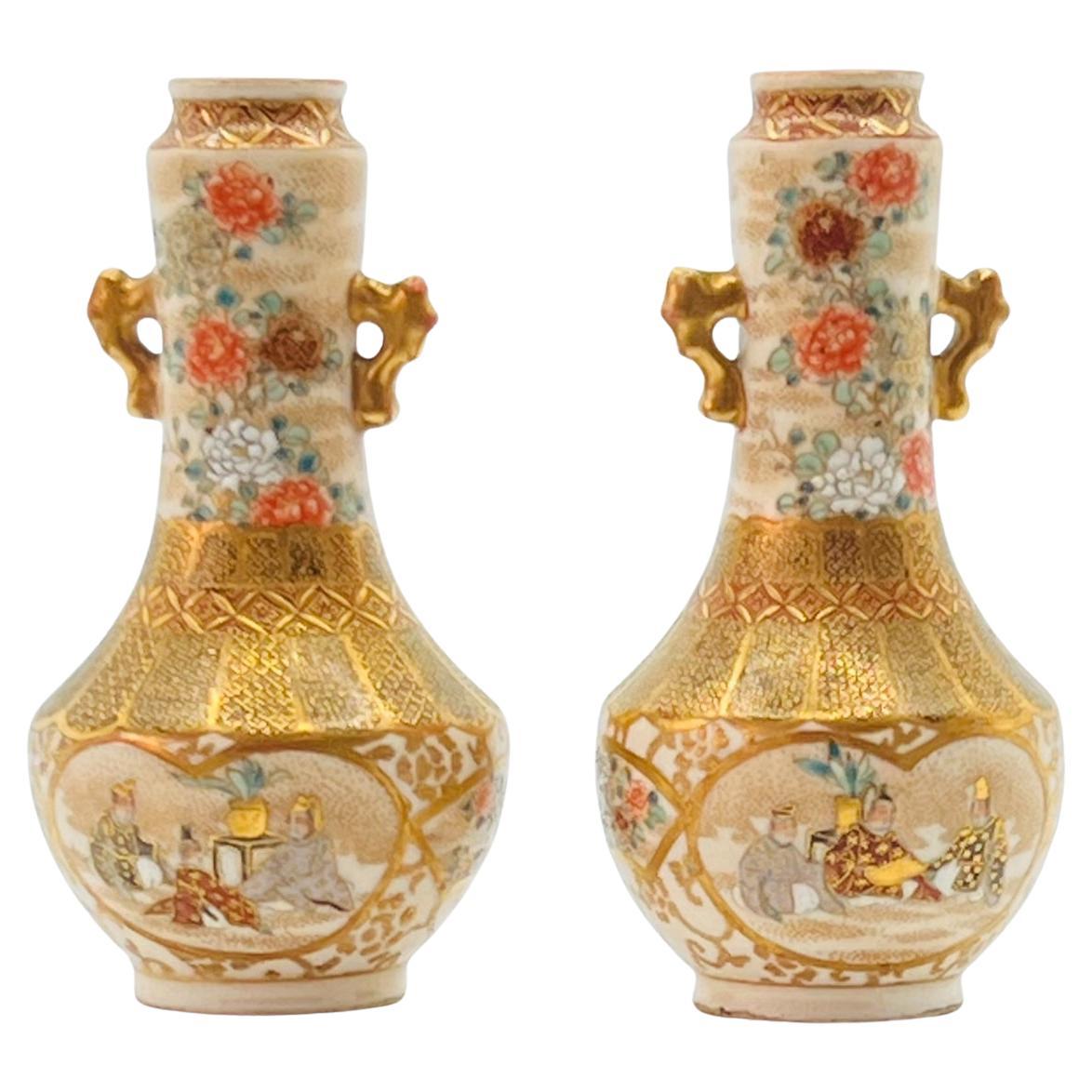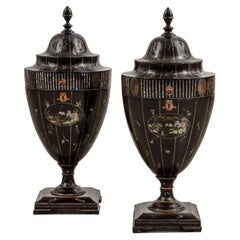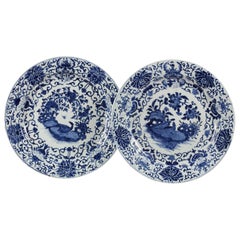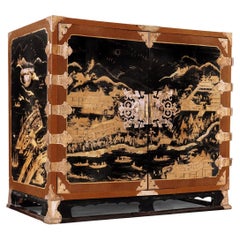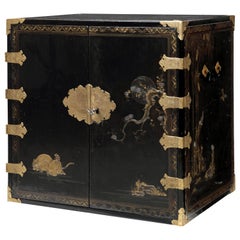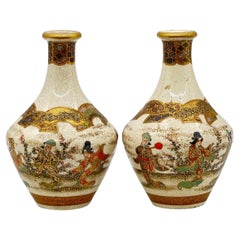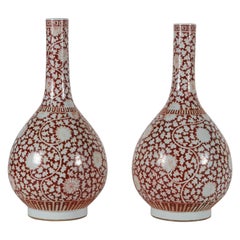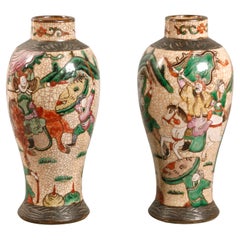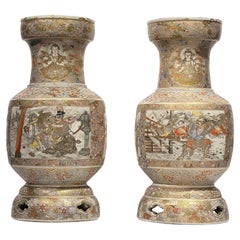Items Similar to Pair of Amsterdam Decorated Japanese Arita Bottles, circa 1700
Want more images or videos?
Request additional images or videos from the seller
1 of 5
Pair of Amsterdam Decorated Japanese Arita Bottles, circa 1700
$10,184.22per set
£7,581.49per set
€8,500per set
CA$13,949.84per set
A$15,515.26per set
CHF 8,101.59per set
MX$188,804.24per set
NOK 103,469.64per set
SEK 97,036.27per set
DKK 64,707.53per set
Shipping
Retrieving quote...The 1stDibs Promise:
Authenticity Guarantee,
Money-Back Guarantee,
24-Hour Cancellation
About the Item
Two fine Japanese Arita Amsterdam decorated or 'clobbered' bottles
Edo period late 17th-early 18th century
The smaller one is decorated with a lambrequin and under it, one perched, one flying pheasant and a fly among prunus, peony and bamboo, the larger one with on the belly also one flying, one perched pheasant and a fly and in addition a butterfly amongst tree peony and chrysanthemums under a frieze on the shoulder of cartouches with floral decoration.
?
H. 21 cm, content: 1.4 liter
H. 27.5 cm, content: 2.2 liter
Note:
These bottles arrived undecorated in the Netherlands where they were decorated in the Chinoiserie and Kakiemon style with red, green, blue, black, yellow and aubergine enamels and sometimes with gold.
“Dutch” decorated white Arita bottles are often called “Amsterdam’s bont”. However this kind of decoration was not only done in Amsterdam but in Delft, the Dutch provinces, England and Germany as well. The larger bottle, for instance, is likely to have been decorated in England, Lowestoft.
- Dimensions:Height: 10.83 in (27.5 cm)Width: 4.73 in (12 cm)Depth: 4.73 in (12 cm)
- Sold As:Set of 2
- Materials and Techniques:
- Place of Origin:
- Period:Late 17th Century
- Date of Manufacture:1680-1710
- Condition:
- Seller Location:Amsterdam, NL
- Reference Number:1stDibs: LU5458220872372
About the Seller
5.0
Recognized Seller
These prestigious sellers are industry leaders and represent the highest echelon for item quality and design.
Established in 1985
1stDibs seller since 2020
23 sales on 1stDibs
Typical response time: 2 hours
- ShippingRetrieving quote...Shipping from: Amsterdam, Netherlands
- Return Policy
Authenticity Guarantee
In the unlikely event there’s an issue with an item’s authenticity, contact us within 1 year for a full refund. DetailsMoney-Back Guarantee
If your item is not as described, is damaged in transit, or does not arrive, contact us within 7 days for a full refund. Details24-Hour Cancellation
You have a 24-hour grace period in which to reconsider your purchase, with no questions asked.Vetted Professional Sellers
Our world-class sellers must adhere to strict standards for service and quality, maintaining the integrity of our listings.Price-Match Guarantee
If you find that a seller listed the same item for a lower price elsewhere, we’ll match it.Trusted Global Delivery
Our best-in-class carrier network provides specialized shipping options worldwide, including custom delivery.More From This Seller
View AllPair of Japanese Lacquer and Mother-of-Pearl Inlaid Knife Urns, circa 1800-1815
Located in Amsterdam, NL
A rare pair of Kyoto-Nagasaki style lacquer and mother-of-pearl inlaid knife urns
Edo period, early 19th century
Measures: Height 71 x diameter 30 cm
?Formed as urns with vertically lifting covers and elongated finials, revealing fitted green velvet lined interiors for knives, decorated overall with birds, flowering stems, faux-fluting and oval panels with landscapes. The square plinth is raised on four bracket feet. Inside the lifting cover of one of the urns are Japanese characters, supposedly indications of some code by the craftsman.
A closely related knife urn, now in the collection of the Peabody Essex Museum, Salem (inv. E 73115), was acquired in Nagasaki by Captain Samuel Gardner Derby of the Margareth of Salem in 1801. Captain Gardner Derby traded in Nagasaki under charter from the VOC (Vereenigde Oostindische Compagnie), the Dutch East India Company. Between 1797 and 1814 Holland was occupied by the French and from 1811 until 1816 Java by
the English. During these periods practically no Dutch shipping was possible between Holland and Batavia (Jakarta) or between Batavia (Jakarta) and Nagasaki. To maintain a minimum amount of shipping between Batavia (Jakarta) and Nagasaki, between 1797 and 1807, the VOC chartered mainly American ships. American captains and officers ordered and bought mainly lacquered furniture in an American-English style, completely different from what the Dutch up till then had ordered. The present knife urns were possibly also ordered and acquired by Captain Gardner Derby during his stay in Deshima/Nagasaki in 1801.
Another similarly neoclassical shaped knife urn in the collection of the Ashmolean Museum Oxford (inv. 1996.17) appears to be signed by woodworker Kiyotomo koreo tsukuru (Kiyomoto made this). The same name, together with an address in the Sanjo-Teramachi District of Kyoto, has been found inside a fragmentary urn in a private collection. This is an indication that European-style furniture was not only lacquered in Japan but made there as well. This undoubtedly is not only true for knife-urns, but all European- style furniture lacquered in Japan after circa 1800 was made by Japanese furniture makers...
Category
Antique Early 19th Century Japanese Anglo-Japanese Lacquer
Materials
Brass
$57,510 / set
Free Shipping
Two Chinese Porcelain Kangxi 'Pelgrom' Armorial Chargers, circa 1710
Located in Amsterdam, NL
A pair of very large Chinese armorial export blue and white porcelain 'Pelgrom' chargers
Kangxi period, circa 1710
The two chargers, decorated in...
Category
Antique Early 18th Century Chinese Chinese Export Ceramics
Materials
Porcelain
17th Century Japanese Export Lacquer Cabinet with Depiction the Dutch Tradepost
Located in Amsterdam, NL
A highly important Japanese export lacquer cabinet with depiction of the Dutch East India Company tradepost Deshima and the annual Dutch delegation on its way to the Shogun in Edo
Edo period, circa 1660-1680
H. 88 x W. 100.5 x D. 54 cm
This cabinet includes a later European japanned stand, but also a modern powder-coated steel frame.
The latter can be designed and added to your specific needs.
The sides and front of the rectangular two-door cabinet are embellished in gold and silver hiramaki-e and takamaki-e on a black roiro lacquer ground with a continuous design. The two doors depict a long procession of numerous figures travelling on foot and horseback along buildings and a pagoda into a mountainous landscape. This is the annual court journey, Hofreis, of the Dutch from Nagasaki to the Shogun’s court in Edo. Three horseback riders are dressed as Dutch merchants and a fourth figure, probably het Opperhoofd, is seen inside a palanquin, norimon. Just about to cross the bridge, two men are carrying a cabinet like the present one.
Many Japanese figures on either side of the procession are engaged in various activities; some play musical instruments on board of small boats, others are fishing; figures inside buildings are depicted playing go, and farmers are tending to their rice paddocks. The upper part of the right door shows a large mansion, probably the local daimyo’s castle, with men kneeling before a man in the central courtyard.
The court journey fits in with the foreign policy of the shogunate which accorded a role to the VOC alongside China, Korea, and the Ryukyu Islands who also had to pay tribute. However, the VOC employees were traders, having low status in Japan’s social hierarchy, and they were received with less deference than were the state embassies from Korea and the Ryukyu Islands. Nevertheless, the contacts with the Dutch were a welcome source of information to the Shogun about Europe and European science and technology.
The left side of the cabinet depicts, in mirror image, a rare view of the artificial fan-shaped Deshima Island, the trading post for the Dutch in Japan. The island, where the Dutch flag flies, is surrounded by small Japanese boats and an anchored three-masted fluyt (cargo ship), flying Dutch flags, with on the stern the VOC monogram. On the bottom right a busy street of Nagasaki is shown, bordered by shops and leading up to the stone bridge. On the island the trees are beautifully painted, two cows can be seen, and the flagpole, all in very fine detail. Dutchmen and enslaved Malay are visible outside the buildings and two Japanese figures, probably guards, sit in a small hut in the centre.
A maximum of fifteen to twenty Dutchmen lived on the island at any time and soldiers or women were not allowed. Restrictions on Deshima were tight, and the merchants were only allowed to leave the island by special permission. The Opperhoofd had to be replaced every year, and each new Opperhoofd had to make a court journey to pay tribute, present gifts, and to obtain permission to Margaret Barclay eep on trading. In the distance, many birds fly above the hills and a four-story pagoda can be seen. The right side of the cabinet is painted with other horse riders and their retinue journeying through mountains.
The pair of doors to the front open to reveal ten rectangular drawers. The drawers are decorated with scenes of birds in flight and landscapes with trees and plants. The reverse of the left door with two thatched buildings, one with a ladder, underneath a camelia tree with large blooms; the right door with a three-story pagoda nestled among trees and both doors with a flying phoenix, ho-oo bird. The cabinet, with elaborately engraved gilt copper mounts, hinges, lock plates and brass handles, is raised on an 18th-century English japanned wood stand.
A pair of large cabinets...
Category
Antique 17th Century Japanese Edo Lacquer
Materials
Copper, Gold
$1,497,679
Free Shipping
Rare Charming 17th Century Japanese Lacquer Cabinet with Gilt-Bronze Mounts
Located in Amsterdam, NL
A fine Japanese pictoral style lacquer cabinet with gilt-metal mounts
Kyoto, Edo period, 1670-1690
Decorated in Japanese relief lacquer work, black lacquer ground decorated...
Category
Antique Late 17th Century Japanese Furniture
Materials
Bronze
$44,930 Sale Price
25% Off
Free Shipping
Extremely Fine and Rare 17th-Century Japanese Export Lacquer and Inlaid Cabinet
Located in Amsterdam, NL
An extremely fine and important Japanese lacquer cabinet with gilt-copper mounts for the European market
Edo period, late 17th century
The pictorial style decorated rectangular...
Category
Antique Late 17th Century Japanese Lacquer
Materials
Brass
Price Upon Request
Free Shipping
Portuguese-colonial Japanese Namban lacquer Vargueno Cabinet, circa 1600
Located in Amsterdam, NL
A Portuguese-colonial Japanese Namban lacquer vargueno cabinet
Momoyama period, circa 1600
H. 43 x W. 64.5 x D. 36 cm
Wood, black lacquered and deco...
Category
Antique Early 1600s Japanese Antiquities
Materials
Gold, Brass
You May Also Like
A Fine pair of Japanese Satsuma Vases. Signed Yozan .Meiji Period
Located in London, GB
A Fine Pair of Japanese Satsuma Vases.
Signed to the bottom Yozan.
Meiji Period.
Decorated in satsuma gilt and enamel with a continuous dancing scene of women dancing in tradi...
Category
Antique Late 19th Century Japanese Ceramics
Materials
Ceramic, Porcelain
Fine Pair of Chinese Porcelain Bottle Shaped Vases, Daoguang period (1821-1850)
Located in New York, NY
A fine pair of Chinese porcelain bottle-shaped vases, painted in the Islamic style, Daoguang period (1821-1850). Each vase finely handpainted in Henn...
Category
Antique Mid-19th Century Chinese Chinese Export Ceramics
Materials
Porcelain
pair of Chinese porcelain vases, 19th c.
Located in New York, NY
decorated with scenes of warriors
Category
Antique Late 19th Century Chinese Antiquities
Materials
Porcelain
$1,000 / set
Pair Antique 19th Century Meiji Period Japanese Satsuma Vases
Located in New York, NY
Pair of very fine quality early Meiji period Japanese Satsuma vases, one with its 19th century paper label added by its retailer.
Category
Antique Late 19th Century Japanese Meiji Ceramics
Materials
Ceramic
A Rare and Important Pair of Satsuma Vases by Okamoto Ryozan, Meiji Period
Located in London, GB
A Rare and Important Pair of Satsuma Vases signed Okamoto Ryozan
Meiji period (late 19th century)
Kyoto, circa 1890
Exhibition Standard
Each of tapering square form with a short wai...
Category
Antique 19th Century Japanese Ceramics
Materials
Ceramic, Porcelain
A fine pair of Antique Japanese Satsuma vases. Signed Kyuozan.Meiji Era
Located in London, GB
A fine pair of Japanese satsuma vases.
Meiji period.
Signed by Kyokuzan
of globular body rising to a molded cylindrical neck with gilt handles , decorated to the body with pa...
Category
Antique Late 19th Century Japanese Ceramics
Materials
Ceramic, Porcelain
More Ways To Browse
Antique Furniture Amsterdam
Japanese Arita Blue And White
Arita Blue White
17th Century Arita
Asian Black And Gold Decoration
Hand Painted Pheasant
Blue Pheasant
Antique Japanese Bottles
Kakiemon Porcelain
Delft Tree
Porcelain Pheasant
Prunus Porcelain
German Chinoiserie
Japanese Kakiemon
Antique Dutch Bottles
Black Butterfly Porcelain
Japanese Pheasant
Aubergine Porcelain
